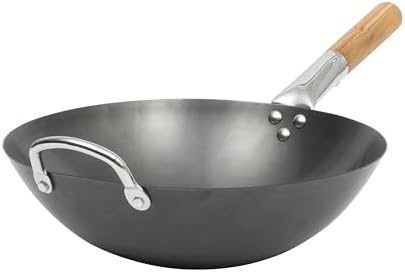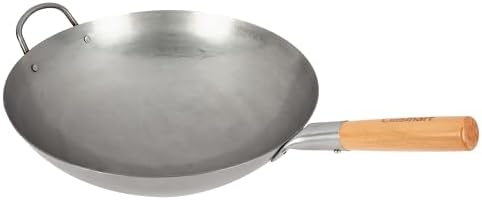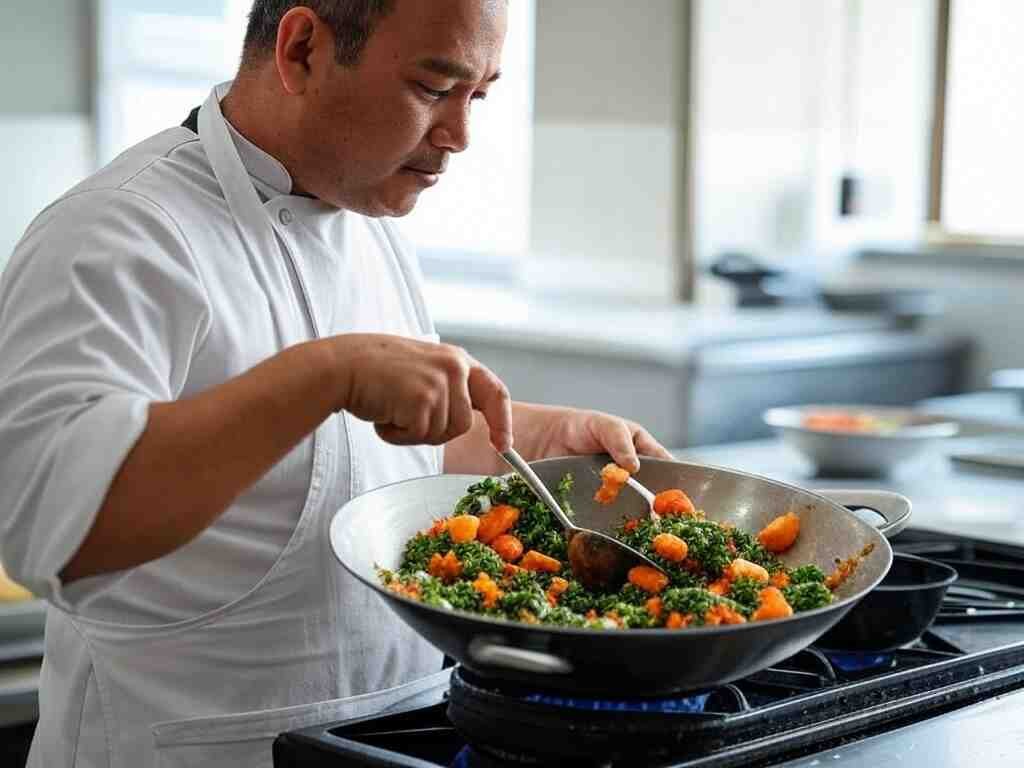Knowing Your Carbon Steel Wok
Carbon steel woks are now very popular in culinary practice. That is because they have a unique cooking capacity that is both versatile and efficient. Made from a thin sheet of carbon steel, the woks are characterized by outstanding heat conduction. This helps them cook quickly and evenly. This allows chefs to achieve high temperatures, which are required for procedures such as stir-frying, searing, and browning. Light weight of carbon steel also makes it convenient to handle. This is also one of the reasons why it is also extremely prevalent in commercial kitchens and home kitchens.
One other aspect of carbon steel worth mentioning is that it tends to form a natural non-stick coating from seasoning. This is achieved through the application of oil to the wok and then heating it. This forms a polymerized fat layer which improves the cooking surface over time. Proper seasoning not only maximizes the wok’s performance but also adds depth to the flavor of the foods that are cooked. Seasoning has to be kept at all times. Without seasoning, a carbon steel wok can be easily overpowered by rusting and sticking.
The reactivity of carbon steel to outer factors like humidity will also lead to the formation of rust. Carbon steel is a reactive material as opposed to other materials. This means food’s acidity can cause it to lose its seasoning and potentially develop off-flavors. Therefore, promptly dry your wok after cleaning. Avoid prolonged exposure to water to ensure its longevity. Proper storage, seasoning, and regular maintenance will prevent most common issues with carbon steel woks. This allows users to enjoy their versatility and cooking efficiency for years.
Common Wok Problems and Their Causes
Carbon steel woks are known for being highly resistant to heat and long lasting. However, users normally have issues that can spoil their cooking experience. The causes of such frequent issues must be grasped in order to troubleshoot appropriately.
Sticking is possibly the most frequent issue users of carbon steel woks have. An issue like this most commonly arises because of an improper seasoning of the surface of the wok. Seasoning creates a non-stick coating. If this step is not done accordingly, food particles will adhere to the surface. Even not having sufficient oil during cooking can exacerbate the issue. When the wok isn’t oiled adequately, foods stick to the metal. This is annoying and leads to a less-than-optimal cooking experience.
Rusting is another common problem. Carbon steel has a tendency to rust if it is not cared for rightly. Rust could develop when the wok is exposed to water. This is particularly true if it is washed and not properly dried afterward. Moreover, if the wok is left in a damp state or unseasoned for an extended period of time, rust development is a certainty. All these conditions coalescing could lead to the weakening of the surface of the wok. This makes it critical that users employ appropriate care strategies.
Inconsistent heat distribution is another problem that can be encountered by cooks. A poorly made or poorly seasoned wok may not be able to distribute heat evenly. This causes hot spots that can impact cooking outcomes. Also, incorrect heat settings can lead to the same. For instance, using a heat setting that is too low can hinder the wok from reaching the optimal temperatures necessary for effective stir-frying. Therefore, the awareness of such factors can allow users to troubleshoot and enhance their performance.
Remedies for Sticking and Rusting Issues
Fixing sticking and rusting issues in carbon steel woks is critical in maintaining their performance and lifespan. It begins with proper seasoning. This forms a protective layer on the wok surface that enhances its non-stick nature. Begin by thoroughly washing the wok with hot soapy water and a scrubbing pad. This removes any factory contaminants. Wash and dry the wok well. Then put a thin coating of high-smoke-point oil. Use grapeseed or flaxseed oil, so that it coats the entire surface evenly.
Preheat your oven to approximately 450°F (232°C). Place the wok upside down in the oven. Preferably, put it over aluminum foil to catch any drips. Bake for about an hour. Afterwards, turn off your oven and leave the wok in the oven to cool. This will season the wok and create a long-lasting non-stick coating.
If rust has already developed, don’t worry. Re-seasoning can rejuvenate your wok. Begin by cleaning the rusty areas with steel wool or baking soda and water. Next, rinse and dry the wok completely. Re-do the seasoning process mentioned earlier. This way, re-seasoning properly covers the surface.
To maintain your carbon steel wok and prevent future issues, develop some cleaning and storage habits. Clean with hot water and mild sponge after each use. Avoid using aggressive detergents that will strip the seasoning. Dry the wok thoroughly before storing it. This does not permit moisture build-up, which can lead to rusting. Also, apply a light coating of oil onto the surface before storing it. This adds an extra level of protection. Doing so will actually fix sticking and rusting problems effectively. This will ensure your carbon steel wok delivers the best performance.
Even Heat Distribution in Your Wok
When cooking using a carbon steel wok, even heat distribution is crucial for an optimal outcome. A well-seasoned wok ensures a better cooking experience. It prevents overheating in certain spots while leaving others cold. One of the major ways of having evenly spread heat is in the form of good preheating. First, do not put anything in the wok and let it heat for a few minutes using medium heat. Let it be until it is evenly heated. This eliminates any cold spots. It also prepares the surface for even cooking.
Using the correct utensils to cook with also matters. Utensils made from wood or silicone work well. They are safe to handle hot and pass heat evenly along the wok’s surface. Metal utensils tend to scratch at times. These will disrupt the seasoning and heat transfer properties of the wok. Check over utensils constantly for wear. Replace them immediately to maintain the best cooking conditions.
Adjusting the heat levels while cooking can significantly improve heat spread. Start with medium-high heat and observe the food closely. If certain ingredients are cooking faster than others, lower the heat so that the food does not cook unevenly. Additionally, frequent stirring helps in heat redistribution. This prevents sticking and helps all ingredients cook evenly. For a precautionary measure, you can also perform a simple heat spread test. Add a small amount of water into the hot wok. It will swirl rapidly, indicating that the heat is evenly distributed.
With the use of these techniques, any individual can have good heat distribution in his carbon steel wok. This leads to better cooking performance as well as higher-quality culinary outcomes. Even heat is what it takes to become a proficient wok cook. This makes wok cooking more enjoyable and successful.












